
|   |

|   |
Portland embraces Odissi Indian dance at first festival - Jamuna Chiarini e-mail: jamunadasi@me.com Photos: Sarathy Jayakumar October 25, 2018 This fall, Portland, Oregon, saw its first-ever Odissi dance festival, and it was extraordinary. The festival, called the 8th Kelucharan Guna Keertanam (it has been offered seven times previously in major Indian and U.S. cities), was produced as a fundraiser for, and in partnership with, the Pratham Education Foundation. Curated by Odissi dancer and choreographer Aparupa Chatterjee, it paid homage to the late Guru Kelucharan Mohapatra, the legendary Indian classical dancer, guru, and exponent of Odissi dance; he is credited with helping revive and popularize this ancient dance form in the 20th century. The festival held on Sept. 23, 2018, featured choreography by Kelucharan Mohapatra, Ratikant Mohapatra, his disciple Chatterjee with her Odissi Dance Company, and Washington State's Urvasi Dance Ensemble directed by Ratna Roy. 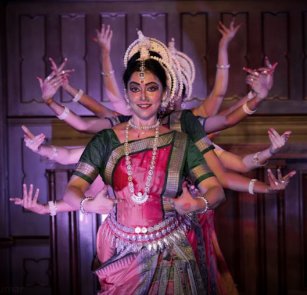 Aparupa Chatterjee with ODC members Because Odissi is deeply rooted in Jagannath culture and Hindu religious practices, using a church as a performance venue made perfect sense. The three-hour program took place in downtown Portland's First Congregational United Church of Christ. This beautiful, 1800s-era Venetian Gothic church has stained glass windows, a bell tower, and an elaborate pipe organ encased in finely carved dark wood that reaches up toward the domed ceiling. This gorgeous, expansive backdrop rivaled the majesty of the Odissi dance tradition itself.  Odissi Dance Company dancers Divya Srinivasa, Yashaswini Raghuram, Swati Yarlagadda, Ramyani Roy, Tanvi Prasad, Aswati Nandakumar and Veena Surya Odissi Dance Company presented six dances, performed by Chatterjee (Fargo, ND), and disciples Aswati Nandakumar (Austin, TX), Divya Chowdhary (NY, NY), Divya Srinivasa (College Station, TX), Ramyani Roy (Houston, TX), Sadrita Mondal (Austin, TX), Swati Yarlagadda (Austin, TX), Tanvi Prasad (Chappaqua, NY), Veena Surya (Chandler, AZ), and Yashaswini Raghuram (Portland, OR). Dances included two works by Guru Kelucharan Mohapatra: Dashavatar, a depiction of Lord Vishnu's ten avatars, and Vande Mataram, an invocation and tribute to mother India. Ratikant Mohapatra's Patadeep Pallavi and Natangi were both technical, pure dance without narrative. Among recent neo-classical works, Chatterjee's Jo bajhe Hari ko sada described Krishna or god as the ultimate goal of one's life, and her work with Ratikant Mohapatra, Ye ho Vithala, described Krishna's beauty. 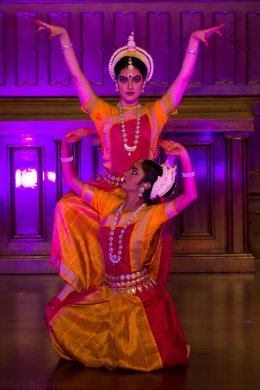 Divya Chowdhary and Tanvi Prasad Based on their performance, you might assume that the ODC dancers live near each other and practice together often because of the synchronicity and continuity of their movements and form. But they all live in different states around the U.S. They learn from Chatterjee, practice daily on their own, and rehearse together several times a week online. Considering that most Odissi dance is performed solo, it's a powerful experience to see an idea multiplied tenfold by a full company; it makes statements and ideas that are much stronger. The choreography, which felt fresh and new but stayed true to traditional Odissi vocabulary, is a credit to the continued efforts of Ratikant Mohapatra imbibed by his disciple Chatterjee to contemporize Odissi. It played with patterns, formations, and relationships, creating tableaux that brought to life the stories and personalities of Hindu mythology. No one dancer from ODC seemed to really shine above the rest because they performed together so seamlessly as a company. The choreography, in fact, isn't intended to draw attention to any one individual. But I will say that my eye was often drawn to Chatterjee, an exceptional dancer and mesmerizing performer. She fully embodies the Odissi dance form and naturally, with ease, expresses an array of emotions while she is dancing. For her, dancing and performing seem as natural as breathing. I also enjoyed the dancer from New York whose serene facial expressions and soft lyrical movements were juxtaposed with her grounded presence. Commanding multiple energies and forces in the body at once makes for a dynamic and interesting performer. The dancer from Portland is also an exceptional performer whose movements are quick and dynamic as well as soft and lyrical, sometimes reminding me of a hummingbird. 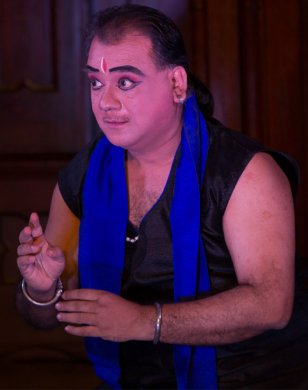 Ratikant Mohapatra Ratikant Mohapatra choreographed and performed the solo Shabari, about a woman who, after a lifetime of waiting, finally meets Lord Rama. Mohapatra's quiet, introspective, unadorned performance moved one to tears. His expressions and gestures very clearly depicted Shabari's longing and love for Lord Rama. It's amazing that such a "simple" dance could so powerfully transcend time and geography to communicate so effectively. The Urvasi Dance Ensemble performed two works; Bandha Thali Sthayi, which combines three Odissi dance styles (Sthayi, Bandha, Thali), and Shakti, a depiction of primal female power inspired by Roy's research of the Yogini and Shakti temples in Odisha. The choreography is by Guru Pankaj Charan Das and Roy. The performers--Marissa Betz-Zall, Moria Chappell, Sukanya Nanda, Douglas Ridings, Jamie Lynn Colley, Ashlesha Mishra, Megha Mishra, and Suma Mondal--wore red and black Odissi costumes, a nice visual counter balance to ODC's brighter, jeweled-toned costumes. 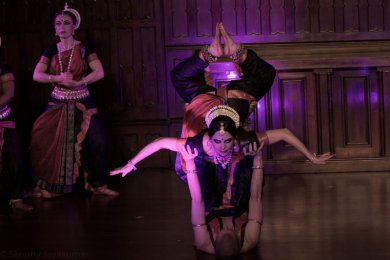 Moria Chappell and Douglas Ridings with Marissa Betz-Zall in the back Toward the end of Bandha Thali Sthayi, the Urvasi dancers suddenly broke from the dancing and walked forward to collect the medium-sized brass plates they had entered with, which held two smaller plates and two candles. After splitting into two lines, the three dancers in the back row balanced the smaller plates on their hands while spinning on their knees. Ridings and Chappell, who were in the front row, performed headstands on the plates while slowly moving their legs in and out of splits in air. Viewers were so wowed by Urvasi's acrobatic skills that they jumped out of their seats and rushed toward the stage to take pictures. This choreography was definitely an unexpected but exciting twist. 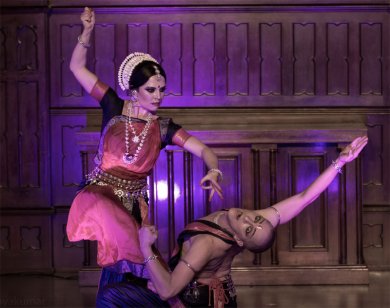 Moria Chappell and Douglas Ridings Shakti was no less resplendent, with intense energy, spinning knee crawls, yogic hand balances, dramatic backbends, and a tableau depicting the multi-armed warrior goddess Durga, another form of the goddess Shakti. In a dramatic moment, Ridings, lying with his back on the floor, held Chappell above him by her shoulders and hips in a flying warrior yoga pose, her arms outstretched, back arched, and legs pointed toward the sky in a diamond. Odissi dance demands athletic rigor, grace, emotional and spiritual investment, and strong technique. In Odissi, the dancer is the personification of the music. Whenever I watch an Odissi dancer, I imagine that I am seeing the sounds of the instruments emanating from the movements of the dancer's body. I see the drum when the dancer's feet strike the floor; the softer, more melodic sounds of the voice, flute, and the tanpura, when the torso and arms move; and the metallic ding of the rhythmic brass cymbals when a dancer's head moves side to side, causing the jhumka earrings to sway. I hope this festival will continue to grow and create new audiences. Jamuna Chiarini is a professional dancer, choreographer, and dance critic for Oregon Arts Watch in Portland, Oregon. She studied dance at the Oakland Ballet School, The School of The Hartford Ballet, and Florida State University. She is the founder of The Outlet Dance Project in New Jersey, a 14 year running festival dedicated to showcasing the work of women choreographers and filmmakers. |